Understanding Paternity Test Results
Paternity tests are used to determine if a man is the biological father of a child. These tests analyze DNA samples from the alleged father, the child, and sometimes the mother. Results are typically reported as a probability of paternity, indicating how likely it is that the tested individual is the biological father.
How Paternity Tests Work
Collecting DNA Samples
DNA samples are usually collected using a buccal swab, which involves rubbing a cotton swab inside the person’s cheek. This method is non-invasive and painless.
Glossary of Terms
Term | Description |
Allele | A version of a gene at a specific location on a chromosome. |
Buccal Swab | A method for collecting DNA samples by swabbing the inside of the cheek. |
DNA | Deoxyribonucleic acid, the hereditary material in humans and almost all other organisms. |
Exclusion | A result indicating that the tested man is not the biological father of the child. |
Inclusion | A result indicating that the tested man is likely the biological father of the child. |
Locus (Plural: Loci) | A specific, fixed position on a chromosome where a particular gene or genetic marker is located. |
Probability of Paternity | The statistical likelihood that the tested man is the biological father of the child, usually expressed as a percentage. |
Analyzing the Results
The laboratory analyzes the DNA samples to see if there is a match. The results are then calculated to determine the probability of paternity.
Understanding the Results
Paternity test results are typically expressed as a percentage. A high percentage (99% or above) indicates a high probability that the individual is the biological father, while 0% indicates that the individual is not the biological father.
Understanding the different parts of the Paternity DNA Report
The report is basically divided into 4 parts.
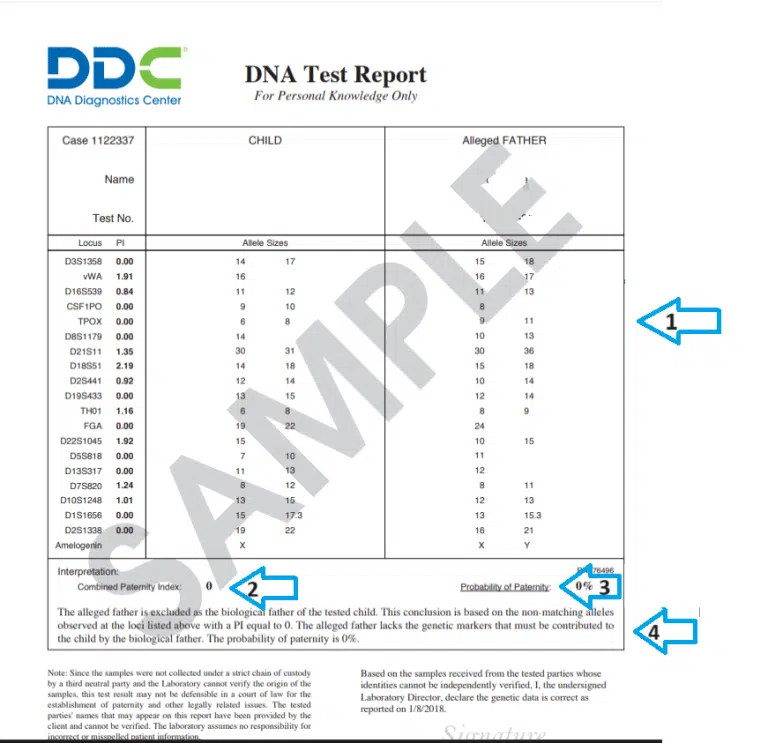
(illustration for ease of understanding)
- Genetic System table: contains all the data results in the report
- Combined Paternity Index: odds ratio indicating biological relations of tested individual against a randomly selected individual from the public.
- Probability of Paternity: This is based on the Combined Paternity Index and is calculated by genetic scientists using a mathematical formula widely accepted in DNA relationship testing.
- Test Conclusion: This paragraph contains the interpretation and test conclusion by the DNA scientists
Understanding the Genetic System Table in Paternity Testing
Paternity testing by DDC involves a detailed analysis presented in the Genetic System Table, a crucial part of the paternity test report. This section is designed to offer a comprehensive overview of the testing process and its outcomes, ensuring clarity and precision in the results.
The Basis of DNA Comparison
The core of paternity testing lies in comparing DNA at specific locations, known as loci. DDC meticulously examines at least 20 distinct loci for each individual involved in the test. The comparison of these loci across the tested parties helps establish a genetic link between a child and the potential father.
Inheritance of DNA Segments
At each of these loci, a child possesses two alleles: one inherited from the mother and one from the father. Alleles are essentially segments of DNA, with each allele’s length denoted by a specific number in the test report. For a man to be identified as the biological father, his alleles must match at least one allele at every locus with those of the child.
Matching Alleles and Genetic Mutations
A perfect match across all examined loci typically indicates paternity. However, it’s important to note exceptions due to rare genetic mutations, which may lead to mismatches. A significant number of mismatches, on the other hand, lead to an exclusion, signifying that the tested man is not the biological father.
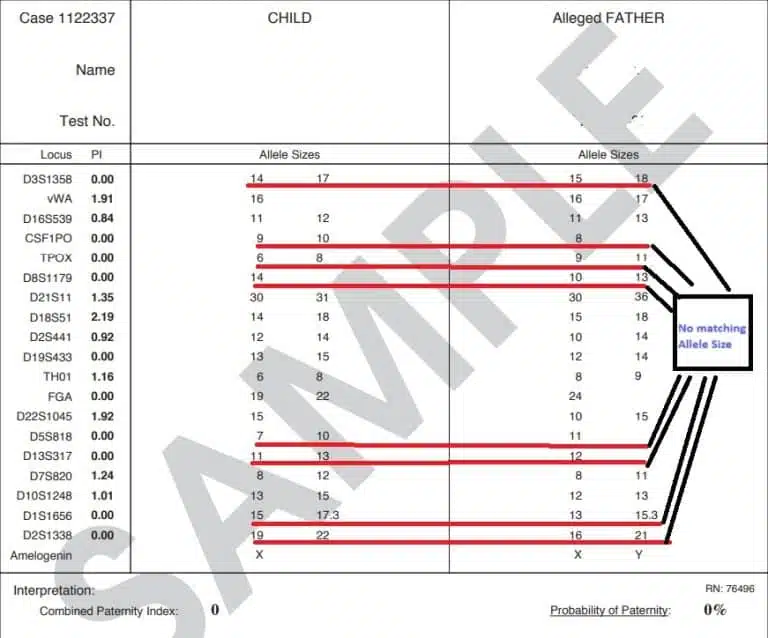
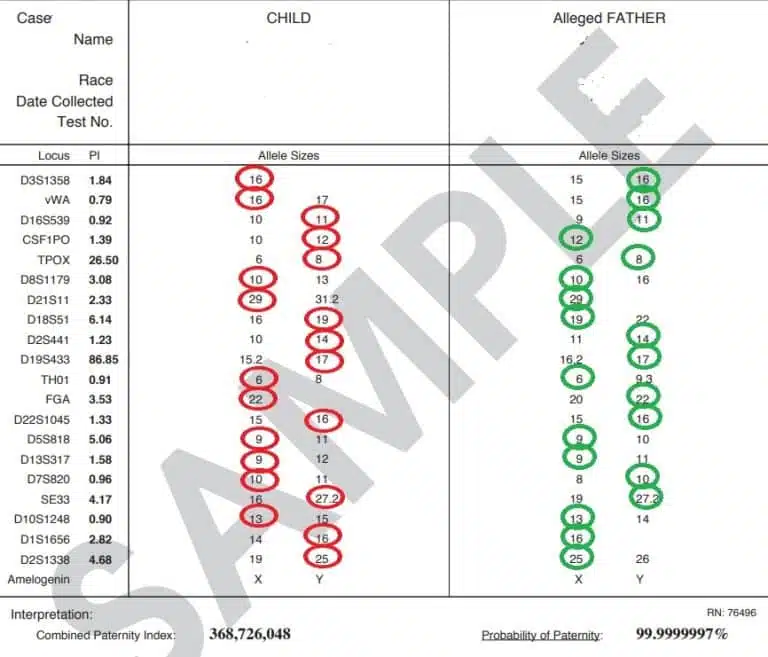
Understanding Allele Representation
Occasionally, the report may show a single allele at a locus instead of two. This should not cause concern; it simply means that the alleles from the mother and the potential father are identical in length. For instance, a notation of “11” actually represents two alleles of the same length, effectively “11,11.”
The Amelogenin Sex Chromosome
The report also includes information on the Amelogenin sex chromosome, which helps determine the sex of the child. A single “X” in the report for a female child stands for “XX,” indicating her sex chromosomes.
Understanding the Combined Paternity Index
When it comes to paternity testing, understanding the results can be as crucial as the results themselves. One key component of these results is the Combined Paternity Index (CPI), a statistical measure that plays a vital role in determining paternity. Let’s break down what the CPI is, how it’s calculated, and what it means in simple terms.
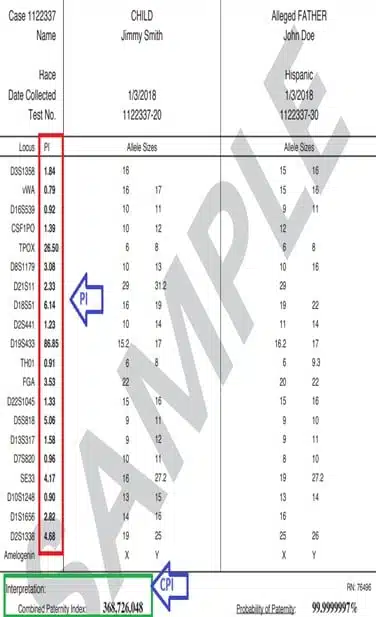
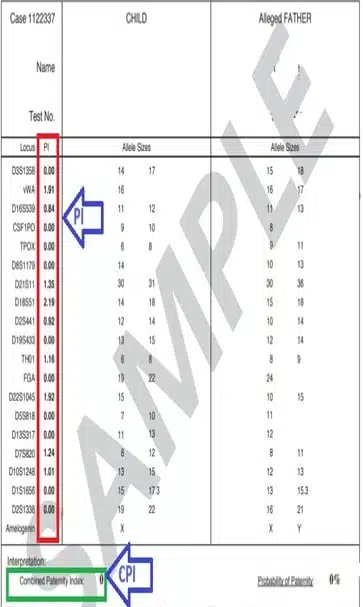
What is the Paternity Index (PI)?
Before we dive into the CPI, it’s important to understand the Paternity Index (PI). The PI is a number that represents the strength of the genetic match between the possible father and the child at each tested location (locus) on their DNA. The value of the PI can vary greatly, but the basic rule is straightforward: the higher the PI, the stronger the genetic match. If the DNA at a specific locus does not match between the child and the possible father, the PI for that locus is typically 0.0, indicating no match.
Calculating the Combined Paternity Index (CPI)
Example Simplified To put it into perspective with an example from the above given images of Inclusive report (Hover to zoom) : if a CPI calculation results in a figure like 368,726,048, it means the tested man is 368,726,048 times more likely to be the biological father than a random man from the same racial background. The essence of this calculation is to provide a clear, statistical likelihood of paternity, with a higher CPI indicating a stronger likelihood that the tested individual is the biological father.
The Significance of CPI
The CPI plays a crucial role in the conclusion of paternity tests. If the CPI is zero as shown above in the Exclusive Report (Hover to zoom), it means there is no statistical likelihood that the tested man is the biological father, leading to an exclusion in paternity. On the other hand, a high CPI strongly indicates that the man is the biological father, given the statistical improbability of such a match occurring by chance.
Understanding the Probability of Paternity
Calculating the Probability The actual calculation of the Probability of Paternity is performed using a well-established mathematical formula that’s widely accepted in the field of DNA relationship testing. This formula takes the CPI and translates it into a percentage that represents the likelihood of paternity. High Probability: 99.9% or Higher
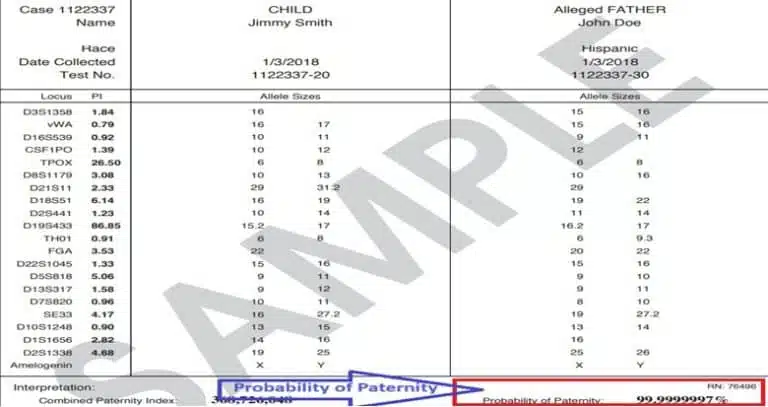
When the calculated Probability of Paternity is 99.9% or higher, it signifies an extremely high likelihood that the tested man is the biological father of the child. Such a high percentage is considered conclusive evidence of paternity in legal and personal contexts.
Zero Probability: 0%
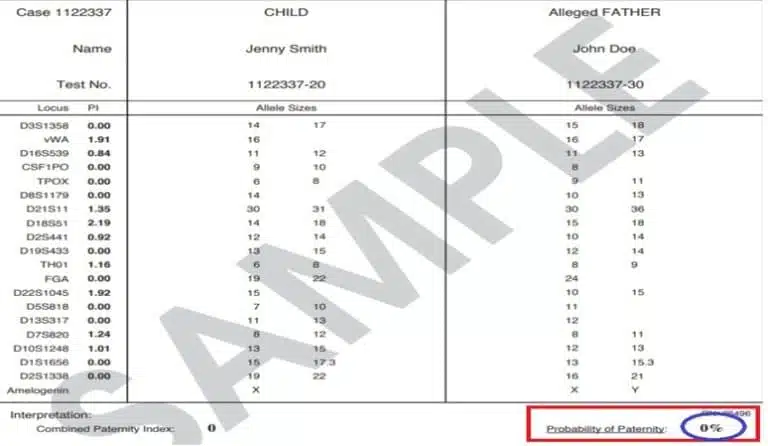
Why Not 100%? A common question is why the Probability of Paternity never reaches a full 100%. The answer lies in the statistical nature of DNA testing. To achieve a probability of 100%, one would need to compare the DNA of the child with that of every other man of the same racial background across the globe, which is, of course, impractical. Therefore, while a Probability of Paternity of 99.9% or higher is as close to certain as scientifically possible, it cannot logically be rounded up to 100%.
Understanding Test Conclusion
In the realm of paternity testing, the final section of the report holds the key to answering the pivotal question of biological relationship: Is the tested individual the biological father of the child? This section, known as the “Test Conclusion,” succinctly summarizes the findings of the DNA analysis. Given the inherent statistical nature of DNA testing, where a probability of paternity is never an absolute 100%, specific terminology is employed to convey the results clearly and accurately.
The Meaning of “Excluded” and “Not Excluded”
The Test Conclusion uses two critical terms to indicate the outcome of the test: “excluded” and “not excluded.” These terms are chosen carefully to reflect the scientific precision of the testing process.
"Not Excluded as the Biological Father"

When the conclusion states that an individual is “not excluded” as the biological father, it signifies a high probability of paternity. In layman’s terms, this means that based on the DNA evidence analyzed, the tested man is most likely the biological father of the child. This conclusion is drawn from a combination of genetic markers that strongly suggest a biological link between the child and the potential father.
"Excluded as the Biological Father"

Conversely, if the conclusion states that an individual is “excluded” as the biological father, it indicates that the DNA evidence does not support a biological relationship between the tested man and the child. In this case, the likelihood of paternity is so low (effectively 0%) that the scientific consensus is that the man is not the biological father.
Paternity Test Results: A Simple Guide To Truth
To conclude, when you get a paternity test report, it tells you if the tested man is likely the biological father of a child or not. Let’s break down the main parts of this report in an easy-to-understand way.
“Excluded” or “Not Excluded”
- “Not Excluded” means the test found that the man is very likely the biological father.
- “Excluded” means the test found that the man is not the biological father.
These terms help you quickly see the test’s main finding.
The Combined Paternity Index (CPI)
Think of the CPI like a score that shows how strong the match is between the man’s and the child’s DNA. A higher score means a stronger match, making it more likely that the man is the father.
Probability of Paternity
This is a percentage that tells you how likely it is that the man is the father. If it’s 99.9% or higher, it’s almost certain he’s the father. A 0% means he’s not the father.
Why This Matters
Understanding these parts of your paternity test can help you know more about your family’s biological connections. It’s a way to get clear answers using science.
In short, paternity tests use DNA to see if a man is likely the father of a child. The report uses special terms and percentages to show you the results in a straightforward way. This helps everyone involved make informed decisions about what to do next.
To know more about our Corporate Partner Labs accredition click here
